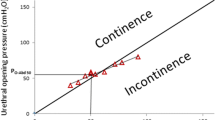Abstract
This prospective study aims to evaluate the relationship between urethral resistance pressure (URP) and pressure flow parameters in women with lower urinary tract symptoms (LUTS). Consecutive women with LUTS attending three tertiary referral urodynamic clinics were asked to undergo urodynamic evaluation, pressure flow studies and URP measurement. The pressure flow parameters such as detrusor pressures at the start of flow (ODP), detrusor pressure at peak flow rate (PdetQmax), peak flow rate (Qmax) and detrusor pressure at the end of flow (CDP) were measured. The relationship between URP and pressure flow parameters was evaluated as well as differences between each urodynamic group. Two hundred seventy-nine women attended for urodynamic investigations. Two hundred twenty-three (79.9%) women had good quality pressure flow measurements and were included in the study. The mean age was 58 years (range 21–83). Women with urodynamic stress incontinence had significantly lower URP and ODP than those with detrusor over-activity [54.8 (±17.9) and 12.4 (±4.1) cmH2O, respectively, vs 85.6 (±21.4) and 33.7 (±13.3) cmH2O, respectively) (p<0.05, Bonferroni test). Furthermore, women with urodynamic stress incontinence have significantly lower PdetQmax values as well as higher Qmax than women with competent urethral sphincters (p<0.05, Bonferroni test). There was a significant correlation between ODP, PdetQmax, Qmax and URP measurements. In urodynamic stress incontinence, both URP and pressure flow parameters are reduced. Although the trend for values of both tests were similar and there was a significant correlation between these tests, we should consider that urethral function at rest differ from that during voiding due to activation of additional mechanisms. Therefore, further study is needed to confirm our results.
Similar content being viewed by others
References
Digesu GA, Hutchings A, Salvatore S et al (2003) Pressure flow parameters in female: reliability studies. BJOG 110:774–776
Digesu GA, Hutchings A, Salvatore S et al (2004) Pressure flow study: a useful diagnostic test of female lower urinary tract symptoms. Neurourol Urodyn 23:104–108
Wagg AS, Lieu PK, Ding YY et al (1996) A urodynamic analysis of age associated changes in urethral function in women with lower urinary tract symptoms. J Urol 156:1984–1988
Lemack GE, Baseman AG, Zimmern PE (2002) Voiding dynamics in women: a comparison of pressure-flow studies between asymptomatic and incontinent women. Urology 59:42–46
Karram MM, Partoll L, Bilotta V, Angel O (1997) Factors affecting detrusor contraction strength during voiding in women. Obstet Gynecol 90:723–726
Slack M, Culligan P, Tracey M et al (2004) Relationship of urethral resistance pressure to urodynamic measurements and incontinence severity. Neurourol Urodyn 23:109–114
Slack M, Tracey M, Hunsicker K et al (2004) Urethral retro-resistance pressure: a new clinical measure of urethral function. Neurourol Urodyn 23:656–661
Digesu GA, Khullar V, Cardozo L, Salvatore S (2003) Overactive bladder symptoms: do we need urodynamics? Neurourol Urodyn 22(2):105–108
Poston GJ, Joseph AE and Riddle PR (1983) The accuracy of ultrasound in the measurement of changes in bladder volume. Br J Urol 55:361–363
Schafer W, Abrams P, Liao L et al (2002) Good urodynamic practices: uroflowmetry, filling cystometry, and pressure-flow studies. Neurourol Urodyn 21(3):261–274
Abrams P, Cardozo L, Fall M et al (2002) The standardisation of terminology of lower urinary tract function: report from the Standardisation Sub-committee of the International Continence Society. Neurourol Urodyn 21:167–178
Digesu GA, Athanasiou S, Chaliha C et al (2006) Urethral retro-resistance pressure and urodynamic diagnoses in women with lower urinary tract symptoms. BJOG 113(1):34–38
Athanasiou S, Khullar V, Boos K, Salvatore S, Cardozo L (1999) Imaging the urethral sphincter with three-dimensional ultrasound. Obstet Gynaecol 94:295–301
Author information
Authors and Affiliations
Corresponding author
Rights and permissions
About this article
Cite this article
Digesu, G.A., Chaliha, C., Khullar, V. et al. The relationship of urethral resistance pressure and pressure flow parameters in women with lower urinary tract symptoms. Int Urogynecol J 18, 493–497 (2007). https://doi.org/10.1007/s00192-006-0181-z
Received:
Accepted:
Published:
Issue Date:
DOI: https://doi.org/10.1007/s00192-006-0181-z




